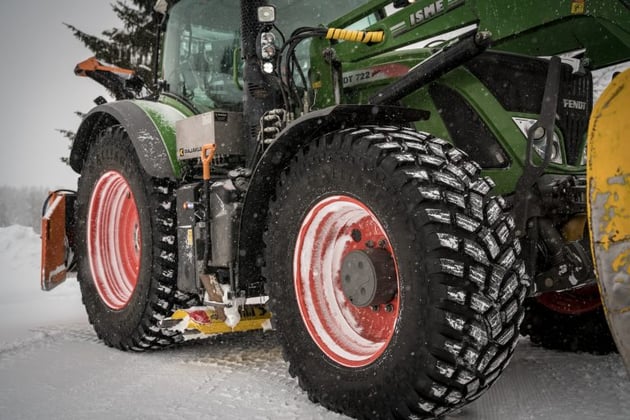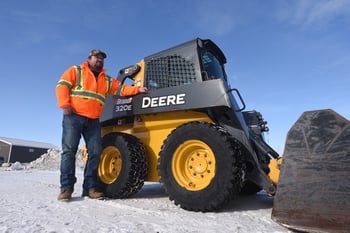Tips to Stay Safe While Inspecting Farm Tires in the Winter
Best Practices for Safer Winter Ag Tire Inspection
In order to ensure everything is ready to roll in the spring, it’s common to inspect the tires of tractors, implements, and other farm equipment in the winter. Farms are filled with potential hazards and winter only ups the ante of something going sideways. Factors like short dark days, bitter cold, slick snow, and treacherous ice all pose additional challenges to farmers, tire dealers, and other ag tire personnel.
Ben Franklin famously said, “an ounce of prevention is worth a pound of cure.” Follow his sage advice and take a few simple steps to improve your safety while working or visiting the farm this winter.
Cold-Weather Accidents
According to the Bureau of Labor Statistics, there were more than 20,000 ice, sleet, and snow-related injuries in 2017 in the U.S. Whether working in the field, yard, or outbuildings, jobs on the farm are more exposed to these types of injuries compared to those in many other occupations. It’s not just ice, sleet, and snow that jeopardizes the safety of those working on the farm—the cold alone can cause its own difficulties, such as hypothermia and frostbite.
Keeping safe while working in cold weather is further complicated by the fact that it’s difficult to define exactly what is “too cold” to work in. OSHA doesn’t have a specific standard that covers work in cold environments and what constitutes cold in one place, might not in another—it’s likely the Montana rancher and Mississippi cotton farmer have different thresholds for when it’s too cold to work. Furthermore, other considerations like wind, precipitation, and overall health can all contribute to cold stress.
Cold-Weather Safety Tips
Winter on the farm presents a variety of hazards to farmers, farmworkers, and visitors—like ag tire personnel. However, many of the most predominant dangers are mitigated by adopting some simple safety best practices.
Clear Communication
Ideally, when inspecting farm tires, dealers, technicians, and field representatives are accompanied by the farmer or staff member, however, this is not always the case. If working alone, ag tire personnel should make sure someone knows where they’re working and when they expect to finish—this increases the odds that someone will notice if they don’t show up at the right time in the event of an accident.
Carrying a mobile phone or two-way radio is another smart strategy to stay connected while inspecting tires on the farm and ensuring assistance in case of emergency.
Know What Weather to Expect
“Failing to prepare is preparing to fail” is another well-known quote from Ben Franklin that applies to staying safe on the farm in winter. Whether it’s watching the weather on the local news, tuning into the weather channel, or clicking a popular app like AccuWeather or Yahoo Weather, knowing the forecast is key to getting ready for a farm visit and making sure you show up with the right gear.
Understanding the weather forecast also allows for proactive scheduling. For example, if inclement weather is predicted in the afternoon, get outdoor tasks out of the way in the morning. Similarly, when the weather is particularly frigid, save the winter jobs most exposed to the cold for the warmest part of the day, which is typically early in the afternoon.
Dress for the Job

It’s also a good idea to keep a change of clothes close by during the winter—getting out of wet layers is a great way to stay both warm and safe in the winter. Another smart suggestion is to keep a stock of chemical hand and feet warmers nearby, as they’re remarkably good for thawing out freezing fingers and toes.
Take a Break
It’s tempting to try to complete cold-weather jobs quickly—like inspecting tires in an unheated barn or open equipment shed—however, knowing when to take a break is critical to working safely in frigid temperatures. Treat signs of cold stress like nausea, fatigue, and dizziness, or a prickly/numb feeling in extremities like hands, feet, ears, or nose by retreating to a warm area. A hot beverage can help warm the body from the inside out, but beware that caffeine can speed up heat loss, so go for a thermos of decaf or hot cocoa rather than a strong cup of joe.
Inspect Another Day
Sometimes the weather is just too extreme to work in and inspecting tires is neither practical nor safe. You can always reschedule a visit, and postponing it for a warmer day can make for a more productive trip, as well as potentially save fingers, toes, or even a life. When in doubt, play it safe!
With harvest in the rearview mirror and planting a few months away, winter is often a time when things slow down on the farm, which is one reason why it’s a popular time for dealers and field representatives to visit. We encourage our customers, dealers, and staff to remember to not get lulled into a sense of complacency by the relatively unhurried pace of winter, keep safety at the forefront of your thoughts, and take steps to ensure your well-being as well as the well-being of those around you.
Contact your local dealer or rep today to learn more about Yokohama Off-Highway Tires America, Inc.’s Alliance, Galaxy, and Primex brand ag tires.
In order to ensure everything is ready to roll in the spring, it’s common to inspect the tires of tractors, implements, and other farm equipment in the winter. Farms are filled with potential hazards and winter only ups the ante of something going sideways. Factors like short dark days, bitter cold, slick snow, and treacherous ice all pose additional challenges to farmers, tire dealers, and other ag tire personnel.
Ben Franklin famously said, “an ounce of prevention is worth a pound of cure.” Follow his sage advice and take a few simple steps to improve your safety while working or visiting the farm this winter.

Cold-Weather Accidents
According to the Bureau of Labor Statistics, there were more than 20,000 ice, sleet, and snow-related injuries in 2017 in the U.S. Whether working in the field, yard, or outbuildings, jobs on the farm are more exposed to these types of injuries compared to those in many other occupations. It’s not just ice, sleet, and snow that jeopardizes the safety of those working on the farm—the cold alone can cause its own difficulties, such as hypothermia and frostbite.
Keeping safe while working in cold weather is further complicated by the fact that it’s difficult to define exactly what is “too cold” to work in. OSHA doesn’t have a specific standard that covers work in cold environments and what constitutes cold in one place, might not in another—it’s likely the Montana rancher and Mississippi cotton farmer have different thresholds for when it’s too cold to work. Furthermore, other considerations like wind, precipitation, and overall health can all contribute to cold stress.
Cold-Weather Safety Tips
Winter on the farm presents a variety of hazards to farmers, farmworkers, and visitors—like ag tire personnel. However, many of the most predominant dangers are mitigated by adopting some simple safety best practices.
Clear Communication
Ideally, when inspecting farm tires, dealers, technicians, and field representatives are accompanied by the farmer or staff member, however, this is not always the case. If working alone, ag tire personnel should make sure someone knows where they’re working and when they expect to finish—this increases the odds that someone will notice if they don’t show up at the right time in the event of an accident.
Carrying a mobile phone or two-way radio is another smart strategy to stay connected while inspecting tires on the farm and ensuring assistance in case of emergency.
Know What Weather to Expect
“Failing to prepare is preparing to fail” is another well-known quote from Ben Franklin that applies to staying safe on the farm in winter. Whether it’s watching the weather on the local news, tuning into the weather channel, or clicking a popular app like AccuWeather or Yahoo Weather, knowing the forecast is key to getting ready for a farm visit and making sure you show up with the right gear.
Understanding the weather forecast also allows for proactive scheduling. For example, if inclement weather is predicted in the afternoon, get outdoor tasks out of the way in the morning. Similarly, when the weather is particularly frigid, save the winter jobs most exposed to the cold for the warmest part of the day, which is typically early in the afternoon.
Dress for the Job

Having proper cold-weather work clothes is essential to staying safe when visiting the farm in winter. A good piece of advice is to dress in layers, which adds adaptability to an outfit and allows for fine-tuning to particular conditions. In general, it’s a good idea to steer clear of cotton in winter (it’s a poor insulator and holds onto moisture, which can sap body heat) and opt instead for synthetic and wool fabrics, which wick moisture. Basic pieces of winter workwear include:
- Thermal long underwear
- Lined work pants and shirt
- Waterproof jacket pants and jacket
- Insulated jacket
- Insulated waterproof boots with good traction (make sure the soles have plenty of life left in them)
- Wicking socks—e.g., made from wool or a synthetic material
- Winter hat
- Warm gloves
- Neck gaiter or scarf
It’s also a good idea to keep a change of clothes close by during the winter—getting out of wet layers is a great way to stay both warm and safe in the winter. Another smart suggestion is to keep a stock of chemical hand and feet warmers nearby, as they’re remarkably good for thawing out freezing fingers and toes.
Take a Break
It’s tempting to try to complete cold-weather jobs quickly—like inspecting tires in an unheated barn or open equipment shed—however, knowing when to take a break is critical to working safely in frigid temperatures. Treat signs of cold stress like nausea, fatigue, and dizziness, or a prickly/numb feeling in extremities like hands, feet, ears, or nose by retreating to a warm area. A hot beverage can help warm the body from the inside out, but beware that caffeine can speed up heat loss, so go for a thermos of decaf or hot cocoa rather than a strong cup of joe.
Inspect Another Day
Sometimes the weather is just too extreme to work in and inspecting tires is neither practical nor safe. You can always reschedule a visit, and postponing it for a warmer day can make for a more productive trip, as well as potentially save fingers, toes, or even a life. When in doubt, play it safe!
With harvest in the rearview mirror and planting a few months away, winter is often a time when things slow down on the farm, which is one reason why it’s a popular time for dealers and field representatives to visit. We encourage our customers, dealers, and staff to remember to not get lulled into a sense of complacency by the relatively unhurried pace of winter, keep safety at the forefront of your thoughts, and take steps to ensure your well-being as well as the well-being of those around you.
Contact your local dealer or rep today to learn more about Yokohama Off-Highway Tires America, Inc.’s Alliance, Galaxy, and Primex brand ag tires.
Comments
Post a Comment